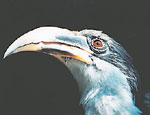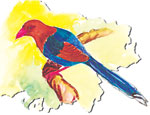|
Endemic birds
The Ceylon grey
hornbill is about the size of a common crow, but with a much longer
bill and tail. It is common in all low-country forested areas, in
both wet and dry zones. It occasionally ascends the hills to 4,000
feet, although it is decidedly rare at such elevations. It lives
in pairs or small flocks except when some wild fig tree is in fruit. \Its favourite abode is the medium levels of tall forests, where hanging creepers and lianas supply convenient perches as well as concealment. It feeds largely on wild fruits, such as the small figs of banyan, wild nutmeg, etc. It also eats any small animal it can catch such as lizards, tree frogs and insects. All items of
food are nipped in the tips of the beak, tossed into the air, caught
and swallowed whole. The breeding season is from April to August.
The eggs number 1 to 3. The nest is a cavity in the bole of a large
tree, usually at some height from the ground. The entrance hole
is sometimes astonishingly small for the size of the bird. The Ceylon grey hornbill is an endemic bird, hence it’s found only in Sri Lanka. It is also considered nationally threatened (1999 List of Threatened Fauna and Flora of Sri Lanka). The main reason for the decline in hornbill populations is the destruction and fragmentation of forests in the island, which serve as its preferred habitat. Kahibella The Sri Lanka Blue Magpie is between a mynah and house crow in size, but has a long and much graduated tail. It can be easily distinguished from other Sri Lankan species due to its distinctive colouring. It is a very energetic and agile bird; most of its time is spent in searching for food among foliage at all levels from the ground to the tops of tall trees. It appears to enjoy wet weather, and is always more noisy in rainy weather. It inhabits the heavy virgin forests of the mountains and wet-zone foothills. The flight is rather weak and seldom long sustained. It associates in flocks up to 6 or 7, but pairs or solitary individuals can sometimes be seen. While satisfying its morning hunger it is generally silent, except for low conversational squeaks and chirps, but at other times it is very noisy, uttering a great variety of loud notes. The breeding season is the first quarter of the year. The nests are usually built at the top of rather small and slender trees in forests and even in village gardens. The nest is untidy and is made of fresh twigs and small branches. The eggs number 3 to 5 and are whitish, profusely spotted and speckled in various shades of brown. The Sri Lanka Blue Magpie is omnivorous. Its diet includes hairy caterpillars, green tree-crickets, beetles, tree frogs, lizards as well as certain types of fruit. The hairy caterpillars are carefully rubbed against mossy branches, presumably to divest them of their stinging hairs. Beetles, frogs, etc., are held firmly under one foot and picked to pieces by the powerful beak. This attractive bird is endemic and hence its population is restricted to Sri Lanka. It’s numbers are increasingly dwindling due to the loss and fragmentation of its habitat - especially due to the rapid destruction of wet zone rain forests in the island. Sinharaja Forest is an ideal place to observe this bird in its natural habitat. Information
from |
||||
Copyright © 2001 Wijeya Newspapers
Ltd. All rights reserved. |
 Alu
Kaendaetta
Alu
Kaendaetta Common
Names:
Common
Names: